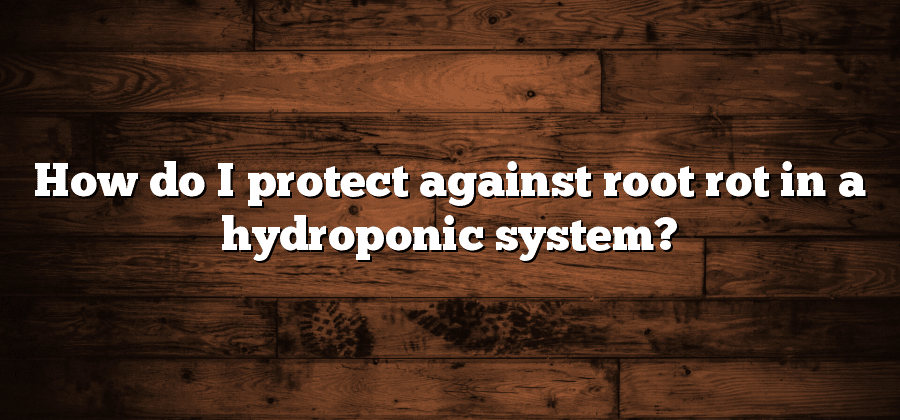Understanding Root Rot in Hydroponics
Root rot is a common and destructive problem that hydroponic growers may encounter. It refers to the degradation and decay of plant roots caused by fungal or bacterial pathogens. This condition can have detrimental effects on plant health and overall crop yields. It is crucial for hydroponic growers to understand the causes, symptoms, and preventive measures associated with root rot to ensure the success of their crops.
One of the main causes of root rot in hydroponics is excessive moisture and lack of oxygen in the root zone. When plants are overwatered or the growing medium becomes waterlogged, it creates an ideal environment for opportunistic pathogens to thrive. These pathogens attack the roots, leading to their decay and the inability of plants to absorb nutrients efficiently. Additionally, poor oxygenation in the root zone can suffocate the roots and further exacerbate the problem. Therefore, maintaining proper oxygen levels and ensuring good drainage in the hydroponic system is paramount in preventing root rot.
Identifying the Signs and Symptoms of Root Rot
Root rot is a common issue that hydroponic growers face and it can have devastating effects on the health and productivity of plants. It occurs when the roots of plants become infected with fungal, bacterial, or viral pathogens, leading to decay and ultimately death. Identifying the signs and symptoms of root rot is crucial in order to take immediate action and prevent further spread within the hydroponic system.
One of the most noticeable signs of root rot is a discoloration of the roots. Healthy roots should have a white or creamy color, but infected roots often turn brown or black. Additionally, the roots may appear slimy or have a foul odor. This sliminess is caused by the excess moisture and lack of oxygen that typically accompany root rot. Another important symptom to look out for is stunted growth or wilting of the plants. As the roots lose their ability to absorb water and nutrients efficiently, the plants may struggle to grow and exhibit signs of nutrient deficiencies.
Importance of Proper Nutrient Management
Proper nutrient management plays a crucial role in the success of hydroponic systems. By understanding the specific nutrient requirements of different plants and providing them in the right quantities, growers can ensure healthy growth and optimal yields.
One key aspect of nutrient management is maintaining a balanced nutrient solution. This involves carefully measuring and adjusting the levels of essential macro and micronutrients, such as nitrogen, phosphorus, potassium, calcium, magnesium, and iron. Imbalances in nutrient concentrations can lead to deficiencies or toxicities in plants, negatively affecting their growth and development. Regular monitoring of nutrient levels and making necessary adjustments is therefore essential to ensure that plants receive the right balance of nutrients for their specific growth stages.
Another important aspect of nutrient management is the use of quality fertilizers. Choosing the right fertilizers that contain the necessary nutrients in readily available forms can significantly boost plant growth and productivity. It is also crucial to consider the solubility and compatibility of fertilizers to prevent clogging or precipitation within the hydroponic system. By selecting high-quality fertilizers tailored to the specific needs of the plants being grown, growers can provide an optimal nutrient environment, promoting healthy root development and overall plant vigor.
In conclusion, proper nutrient management in hydroponic systems is vital for maximizing plant growth and production. By maintaining a balanced nutrient solution and using quality fertilizers, growers can ensure that plants receive the nutrients they require in the most efficient and effective manner. Through diligent monitoring and adjustment of nutrient levels, growers can foster healthy root systems and achieve higher yields in their hydroponic operations.
Maintaining Proper Oxygen Levels in the Root Zone
In hydroponics, maintaining proper oxygen levels in the root zone is crucial for the health and vitality of the plants. Oxygen plays a vital role in the respiration process of plant roots, allowing them to absorb nutrients effectively and thrive. When oxygen levels are insufficient, root rot can set in, leading to stunted growth, wilting, and ultimately the death of the plant.
To ensure optimal oxygenation in the root zone, several factors need to be considered. Firstly, proper water management is essential. Overwatering or inadequate drainage can lead to oxygen deprivation as water fills the root zone, displacing the much-needed oxygen. Therefore, it is crucial to maintain a delicate balance between providing enough water for nutrient uptake and allowing excess water to drain freely. Additionally, using well-aerated growing mediums, such as perlite or coco coir, can help promote oxygen availability in the root zone, enhancing overall plant health and productivity. By prioritizing oxygen levels in the root zone, hydroponic growers can minimize the risk of root rot and ensure their plants receive the necessary oxygen to thrive.






